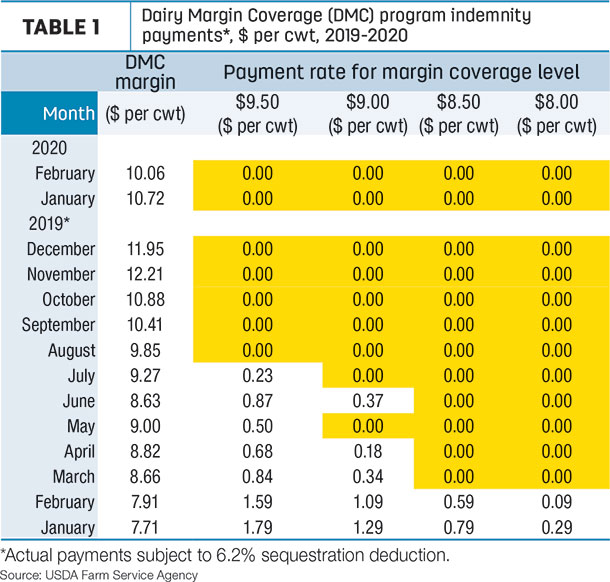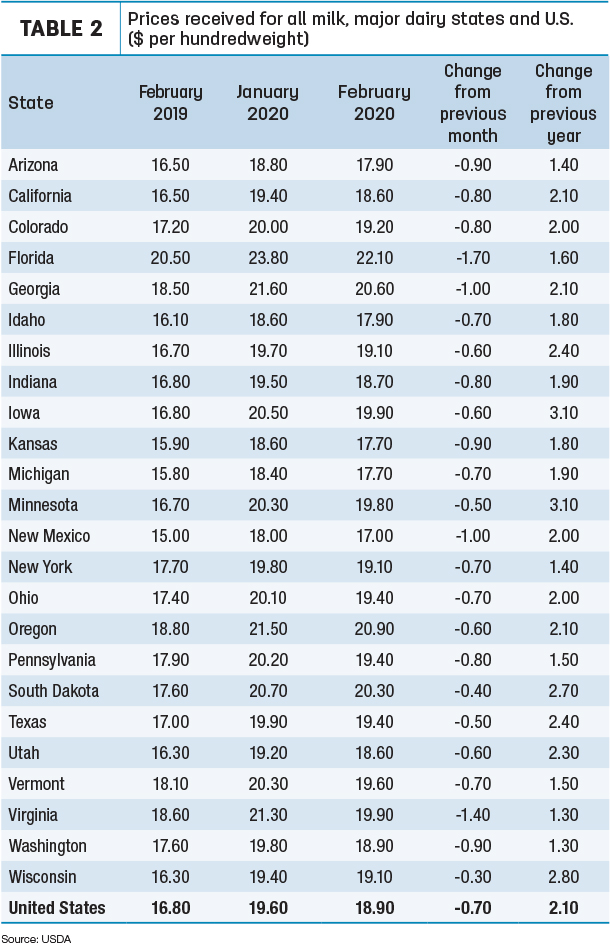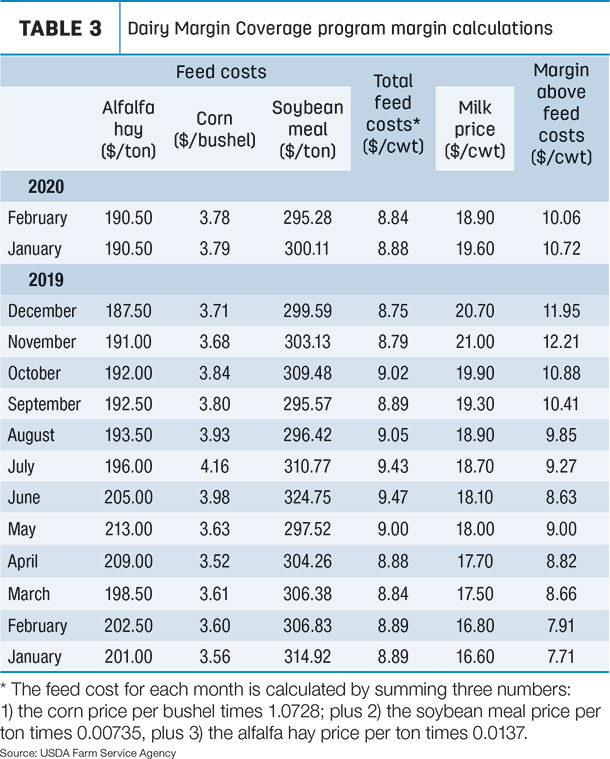- February DMC margin is $10.06 per cwt
- USDA forecasts hay acreage increase
- USDA: Corn, soybean acreage to be up, stocks down
- CDFA extends manure management project grant application period
- FDA reopens comment period on use of UF milk in certain cheeses
February DMC margin is $10.06 per cwt
It may seem like ancient history, but the milk price over feed cost margin calculated under the Dairy Margin Coverage (DMC) program remained above the level triggering indemnity payments on February milk.
The USDA released its latest Ag Prices report on March 31, including factors used to calculate DMC margins and payments. The February DMC margin was estimated at $10.06 per hundredweight (cwt), down 66 cents per cwt from January but still above the highest insurable margin of $9.50 per cwt (Table 1).

- Milk price lower. The February 2020 U.S. average milk price fell 70 cents per cwt from January to $18.90 per cwt. The average was $2.10 higher than February 2019 (Table 2).

Compared to a month earlier, milk prices fell in all major dairy states, with largest declines in Florida and Virginia. Prices remained above year-earlier levels in all major dairy states, led by Iowa and Minnesota, both up $3.10 per cwt from February 2019. Producers in 11 other states saw year-over-year prices up at least $2 per cwt.
The highest milk prices for February 2020 were in Florida ($22.10), Oregon ($20.90) and Georgia ($20.60); monthly lows, all under $18 per cwt, were in Arizona, Idaho, Kansas, Michigan and New Mexico.
- Feed costs steady. February 2020 U.S. average corn ($3.78 per bushel) and alfalfa hay ($190.50 per ton) prices were steady compared to January, with the average price for soybean meal down slightly ($295.28 per ton). That yielded an average DMC total feed cost of $8.84 per cwt of milk sold, down 4 cents from January (Table 3). Feed costs using DMC factors have varied by less than a dime over the past four months.

- Outlook ugly. While the string of months without DMC indemnity payments at any coverage level has now stretched to seven, that’s likely to end.
Based on milk and feed futures prices at the close of trading on March 31, the DMC Decision Tool estimates margins are likely to drop to about $9 per cwt on March milk, triggering DMC indemnity payments at least at the top insured level of $9.50 per cwt. DMC margin factors on March milk will be announced on April 30.
From there, the outlook gets worse. As of March 31, DMC margins were forecast to fall below $6 per in May and June, below $7 in July and August, below $8 in September and October, and below $8.50 for November 2020 through January 2021.
Read also: Dairy ending first quarter of 2020 with coronavirus hangover, toilet paper effect and COVID-19: Adjust dairy risk management strategies to limit losses
USDA forecasts hay acreage increase
There’s still plenty of time and weather to impact 2020 cropping plans, but U.S. producers intend to increase acreage devoted to hay this year, according to the USDA’s Prospective Plantings report, released March 31.
Producers intend to harvest 53.28 million acres of all hay in 2020, up 858,000 acres (2%) from 2019 and the largest total hay acreage since 2017. The report does not differentiate between alfalfa and other hay.
Based on the preliminary estimates, Kansas will see the biggest jump in hay harvest area in 2020, up 420,000 acres from 2019. Nebraska (+200,000), Iowa and North Dakota (each +180,000) will combine to increase hay area by 560,000 acres.
Compared to a year earlier, biggest declines in hay acreage are in Oklahoma (-205,000), Montana (-200,000) and Missouri (-110,000).
California hay area is also expected continue to decline, down 90,000 acres from 2019, to a record-low 920,000 acres. California hay acreage saw its latest peak in 2012 at 1.55 million acres.
Other states indicating record-low hay acreage in 2020 include Indiana, Maine, Massachusetts, Michigan, New Jersey, Ohio, Oregon, Rhode Island and Washington.
Besides California, overall hay acreage in the 24 major dairy states is expected to increase by 775,000 acres, thanks to the strong growth in Kansas and Iowa. Thirteen of the 24 dairy states expect modest increases in hay acreage, with acreage in Colorado, Indiana, Oregon, Texas and Washington forecast to decline.
The acreage estimates in the report are based primarily on producer surveys conducted during the first two weeks of March. Acreage estimates will updated in the USDA’s Acreage report, scheduled for June 30.
USDA: Corn, soybean acreage to be up, stocks down
U.S. farmers intend to plant more corn and soybeans in 2020, according to the USDA’s Prospective Plantings report, released March 31.
Growers intend to plant 97 million acres of corn for all purposes in 2020, up 8% from last year. If realized, this will be the highest planted acreage since 2012. Planted acreage for 2020 is expected to be up or unchanged from 2018 in 38 of the 48 estimating states. Record-high acreage is expected in Arizona, Idaho, Nevada and Oregon. Record-low acreage is expected in Connecticut and Rhode Island. Acreage increases from last year of 800,000 or more are expected in Indiana, Illinois, Ohio and South Dakota.
Soybean-planted area for 2020 is estimated at 83.5 million acres, up 10% from last year. Compared with last year, planted acreage is expected to be up or unchanged in 22 of the 29 estimating states. Increases of 250,000 acres or more are anticipated in Arkansas, Illinois, Kansas, Michigan, Minnesota, Missouri, North Dakota, Ohio and South Dakota.
In addition to the Prospective Plantings report, the USDA also released quarterly Grain Stocks updates.
Corn stocks in all positions on March 1 totaled 7.95 billion bushels, down 8% from a year earlier. Of the total stocks, 4.45 billion bushels were stored on farms, down 13% from a year earlier. Off-farm stocks, at 3.50 billion bushels, are up slightly from a year ago.
Soybeans stored in all positions totaled 2.25 billion bushels, down 17% from March 1, 2019. Soybean stocks stored on farms are estimated at 1.01 billion bushels, down 20% from a year ago. Off-farm stocks, at 1.24 billion bushels, are down 15% from last March.
The 2020 on-farm stocks include 2019 production from acres that were still standing and expected to be harvested when the survey was conducted in early March.
CDFA extends manure management project grant application period
The California Department of Food and Agriculture (CDFA) has extended the application period for grants under its Dairy Digester Research and Development Program (DDRDP) and Alternative Manure Management Program (AMMP). Originally set to close on April 3, the new deadline is April 27.
The CDFA will offer $61 million to $75 million for DDRDP projects and $19 million to $33 million for AMMP projects. Individual grants are for a maximum of $3 million and can cover up to 50% of a project’s total costs.
For information, including a schedule of workshops for grant applicants, visit the CDFA Office of Environmental Farming and Innovation website.
FDA reopens comment period on use of UF milk in certain cheeses
The FDA has extended the comment period on a proposal allowing the use of fluid ultrafiltered (UF) milk in the production of certain cheeses.
The latest comment period was set to close March 30. The new comment period will close 120 days following publication of the notice in the Federal Register.
The proposed rule, which was issued on in 2005, would amend the definitions of “milk” and “nonfat milk” for cheeses and related cheese products in FDA’s standards of identity. In 2017, FDA issued guidance to industry indicating that it is exercising enforcement discretion regarding the use and ingredient labeling of fluid UF milk and fluid UF nonfat milk in the manufacture of standardized cheeses and related cheese products while it considers rulemaking. ![]()

-
Dave Natzke
- Editor
- Progressive Dairy
- Email Dave Natzke






